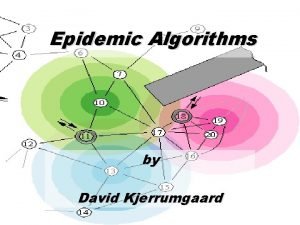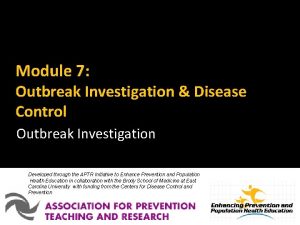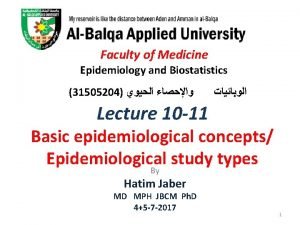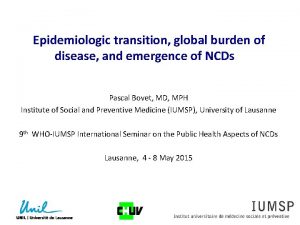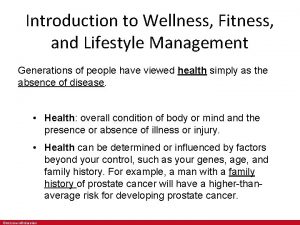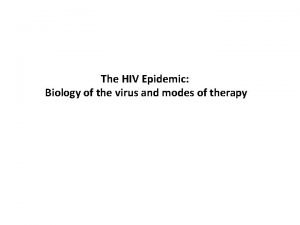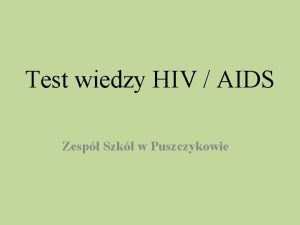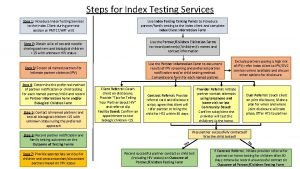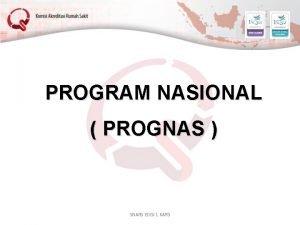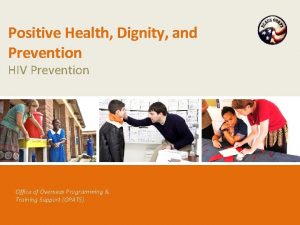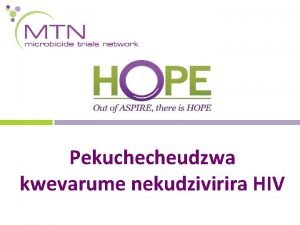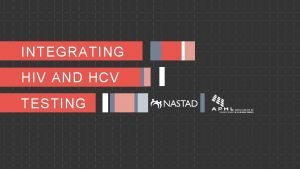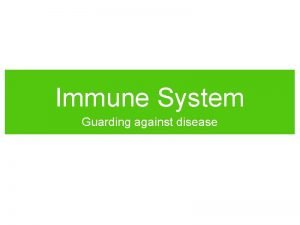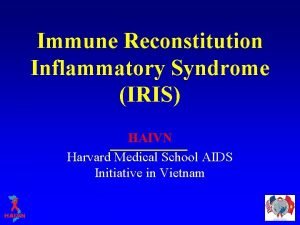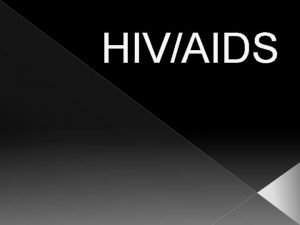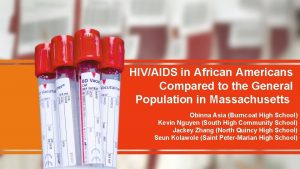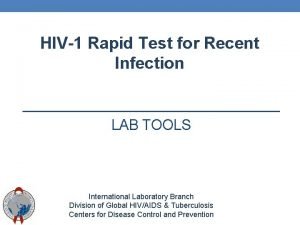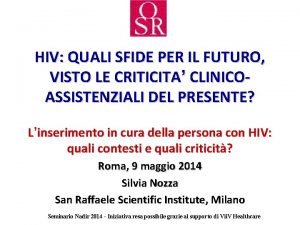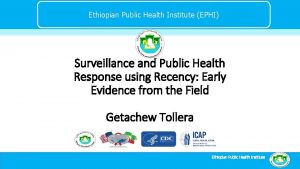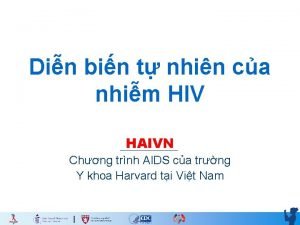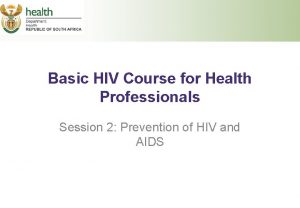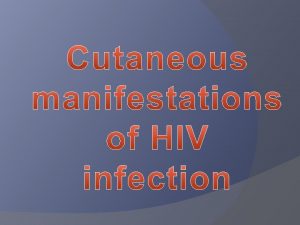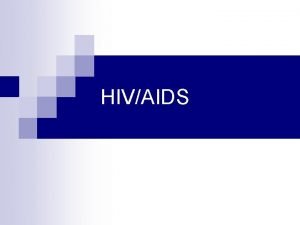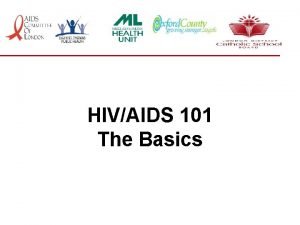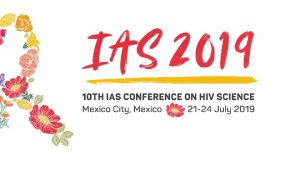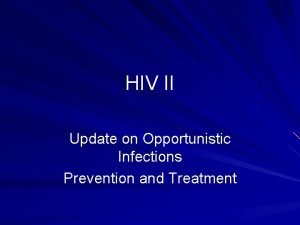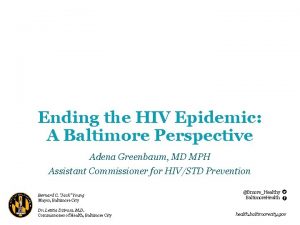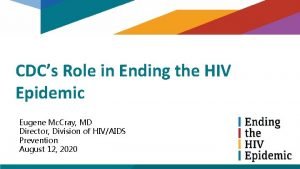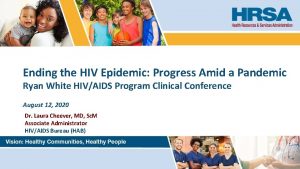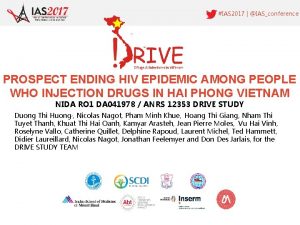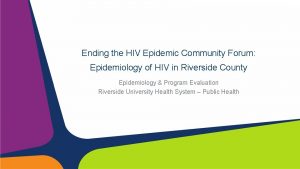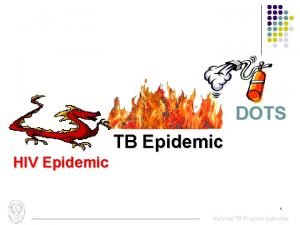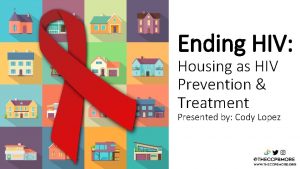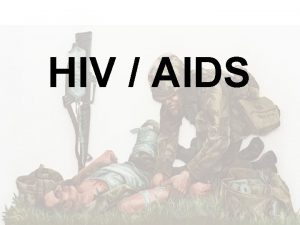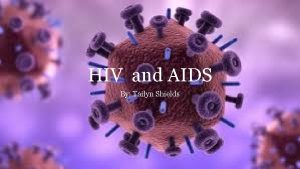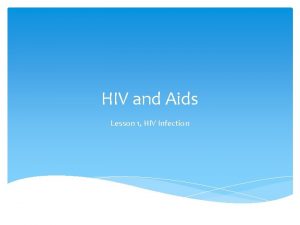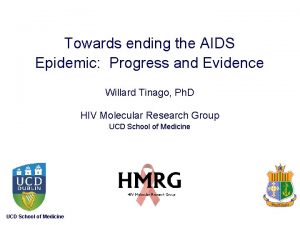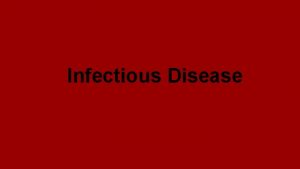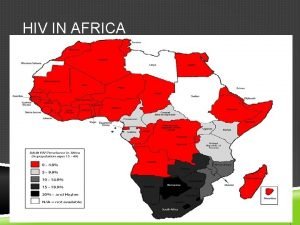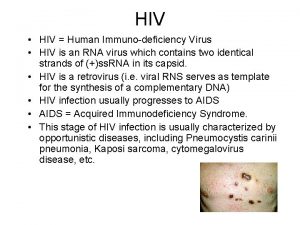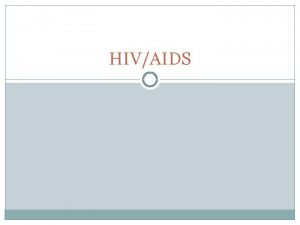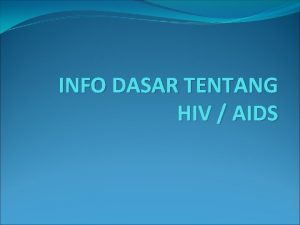Ending the HIV Epidemic Reaching the Unsuppressed and













































- Slides: 45

Ending the HIV Epidemic: Reaching the Unsuppressed and Out of Care Panel Discussion John T. Brooks, MD Laura W. Cheever, MD, Sc. M Chief Medical Officer Division of HIV/AIDS Prevention Centers for Disease Control and Prevention Atlanta, Georgia Associate Administrator Chief Medical Officer HIV/AIDS Bureau Health Resources and Services Administration Rockville, Maryland Dr Brooks and Dr Cheever have no financial affiliations to disclose. (Updated 11/26/19)

2020 National Ryan White Conference on HIV Care & Treatment 30 years of Innovating Care, Optimizing Public Health, Ending the HIV Epidemic § Clinical Conference: August 9 -11, 2020 § National Conference: August 11 -14, 2020 • • Marriott Marquis Washington, DC Abstract Submissions Open: November 18, 2019, through December 20, 2019 2

Ending the HIV Epidemic: Presenters and Panel Members • Two-Pronged Attack: HIV Testing in a South Florida Healthcare System Elizabeth Sherman, Memorial Healthcare System • Crescent. Care’s Immediate ART Continuum Lorna Seybolt, Crescent. Care • The Undetectables Project Andre Brutus, Brooklyn Plaza Medical Center, Inc. • A Multidisciplinary Intervention to Address Patients in Care who are Not Virally Suppressed Paula Seal, Louisiana State University Health Sciences Center • Implementing Tailored Interventions to Improve Retention and Viral Suppression in a Rural Ryan White Clinic Michelle Collins-Ogle, Warren-Vance Community Health Center, Inc.

Four Pillars of Ending the HIV Epidemic Diagnose All people with HIV as early as possible. Treat People with HIV rapidly and effectively to reach sustained viral suppression. Prevent New HIV transmissions by using proven interventions, including preexposure prophylaxis (Pr. EP) and syringe services programs (SSPs). Respond Quickly to potential HIV outbreaks to get needed prevention and treatment services to people who need them.

Identifying the Challenges Ahead People with HIV in care • Improve viral suppression rates • Decrease disparities People newly diagnosed with HIV People with HIV out of care • Enhance linkage to care • Enhance engagement in care • Expand reengagement in care • Improve retention in care

Pr. EP Medication Access for Uninsured Patients HOW CAN PATIENTS PARTICIPATE? • If Pr. EP medication is a good option for your patients, they can choose the application process that is most convenient: § Get. Your. Pr. EP. com § By phone: 855. 447. 8410 § In person at a healthcare • provider’s office, including a community health center where trained staff can assist. Patients can receive Pr. EP medication through a pharmacy of their choice. 6

Thank You! Laura Cheever, MD, Sc. M Associate Administrator John T. Brooks, MD Chief Medical Officer HRSA/HIV/AIDS Bureau CDC/Div HIV/AIDS Prev Lcheever@HRSA. GOV zud 4@CDC. GOV 7

Connect with HRSA To learn more about our agency, visit www. HRSA. gov Brooklyn Plaza Medical Center, Inc. Sign up for the HRSA e. News FOLLOW US: 8

Ending the HIV Epidemic

Ending the HIV Epidemic Test and Link to Care Rapid Start Retention in Care Viral Suppression Re-Engagement in Care

Ending the HIV Epidemic Test and Link to Care Rapid Start Retention in Care Viral Suppression Re-Engagement in Care

Ending the HIV Epidemic Two-Pronged Attack: HIV Testing in a South Florida Healthcare System Elizabeth Sherman, Pharm. D Memorial Healthcare System Dr Sherman has received grant support from Gilead. (11/13/2019)

Goals: Memorial’s HIV Testing Program • The Miami-Ft. Lauderdale-West Palm Beach metropolitan area (MSA) leads USA in new HIV diagnoses and prevalence of diagnosed HIV 1 • Ft. Lauderdale (Broward county) #1 in new HIV diagnoses and HIV prevalence 1 • Memorial Healthcare System is the public healthcare system of south Broward county and one of the largest public healthcare systems in USA • Approximately 80% of new HIV transmissions from persons with undiagnosed HIV or those not in care 2 • Memorial’s large-scale HIV testing program identifies patients who are undiagnosed, or diagnosed and not retained in care, and links them to medical services including our RWHAP-funded clinic 1. CDC. HIV Surveillance Supp Rep 2019; 24(No. 2). http: //www. cdc. gov/hiv/library/reports/hivsurveillance. html. 2. Li Z, et al. MMWR 2019; 68: 267– 272. http: //dx. doi. org/10. 15585/mmwr. mm 6811 e 1.

Methods: 2 -Pronged Approach to HIV Testing 1. Opt-out 4 th generation HIV testing for all patients in emergency department (ED) 2. Point-of-care testing (POCT) for patients in the 9 primary care clinics, aboard the adult mobile health center (AMHC), and for partners/caregivers/family members of patients in clinics/ED • Collaboration with the Gilead Sciences’ FOCUS program and Florida Department of Health • Physician champions: Dr. Randy Katz and Dr. Paula Eckardt

Results: July 2018 - June 2019 1. Opt-out 4 th generation HIV testing for all patients in ED • 22, 067 patients tested • 121 positive (0. 5% reactive rate) • 83 previously diagnosed (53% were engaged in care) • 38 new diagnoses • 104 linked to/retained in care (86% of positives) 2. POCT for patients in primary care clinics, aboard AMHC, and for partners/caregivers/family members • 11, 389 persons tested • 31 positive (0. 2% reactive rate) • 30 (97%) linked to care

Lessons Learned: HIV Testing Program Expansion 1. Opt-out 4 th generation HIV testing for all patients in ED • Frontline ED staff require ongoing training • Stigma remains a challenge: patients and providers afraid to say “HIV” • 83 patients previously diagnosed – but did not disclose status • ED treated 96, 016 patients – yet only 54, 932 were screened 2. POCT for patients seen in the primary care clinics, aboard AMHC, or community members • Testing can impact patient throughput time • Decreasing number of POCT performed as HIV testing is routinized

Further Applications • The Memorial Healthcare System HIV testing program demonstrates an effective HIV testing initiative working to end the HIV epidemic • Knowledge of serostatus is the first step in accessing HIV treatment, reducing transmission, and mitigating public health challenges • HIV testing programs can be rapidly expanded within healthcare systems and can serve to increase testing in communities • If you test them, you will find them!

Ending the HIV Epidemic Test and Link to Care Rapid Start Retention in Care Viral Suppression Re-Engagement in Care

Ending the HIV Epidemic Crescent. Care’s Immediate ART Continuum Lorna Seybolt, MD Crescent. Care Dr Seybolt has no relevant financial affiliations to disclose. (11/13/2019)

Crescent. Care Start Initiative (CCSI): Patients newly diagnosed with HIV seen by a provider within 72 hours (optimally sameday) and provided 30 days of ART Early Intervention Services (EIS): Same protocol but patients contacted clinic over 72 hours after diagnosis Range: 4 days – 25 years

Procedure/Methods Medical Provider Visit: - HIV Lifecycle, importance of adherence, U=U discussed - Comorbidities assessed - Physical Examination - Provider option to not rx, alter medications if suspected resistance - 30 day-supply of TAF/FTC/DTG - DOT –first dose in clinic Post-Provider Visit: - Enroll in insurance programs - Intake Labs obtained - Social Work services for those with urgent needs

Results Category Median Time to Suppression (days) Mean Time to Suppression (days) Number of patients CCSI 1 28 40. 4 227 EIS 2 27 51. 28 141 1. Time from Diagnosis to First Viral Load Suppression: CCSI 2. Time from Linkage to Care to First Viral Load Suppression: EIS

Key Facilitators of RAPID Intervention ● Same-day appointments ● Flexible provider scheduling (on call backup) ● ART-regimen preapproval prior to genotyping or lab testing ● Availability of ART starter packs ● Accelerated process for health insurance initiation ● Observation of first ART dose in clinic (recommended) ● Guarantee sustained access to ART

Concluding Comments • Both cohorts demonstrate that starting patients on the day of diagnosis or linkage, before labs are obtained, is highly accepted, safe and well-tolerated • Rapid entry/initiation improves – Time to viral suppression – Viral suppression at 12 months – Retention in care at 10− 12 months – Survival at 12 months (international studies) • Rapid entry/initiation is feasible in a variety of settings • There are differences between newly diagnosed patients (viral suppression 90%) and those who deferred immediate linkage (viral suppression 77%) P = 0. 0071 • Immediate ART leading to rapid viral suppression will be a key component of ending the HIV epidemic

Ending the HIV Epidemic The Undetectables Project Andre Brutus, MD Brooklyn Plaza Medical Center, Inc. Dr Brutus has served as a speaker for Gilead Sciences, Inc. , Vii. V Healthcare, and Janssen. (Updated 12/2/19)

GOALS In 2018, viral load suppression among new patients dropped 15% from the previous year. Increase viral load suppression by 15% among New Patients (newly diagnosed & new to care) by December 31, 2019.

METHODS – Data Driven ▪ When comparing 2017 data, we learned that our New Patients (particularly those New to Care) significantly impacted the clinic’s overall VLS rate in 2018. 15% drop in new patients VLS in 2018. ▪ In Quarter 1, 2019, the Quality Improvement Team reviewed 2018 viral load suppression data in the electronic medical record by comparing 2018 VLS among New patients versus VLS among Existing Patients. ▪ To address this gap in care, the Quality Improvement Team: A. Conducted a monthly review of the data during QI Meetings to assess which patients’ VL had increased over 200 B. Through reports generated in the EMR, assessed which patients missed clinic or case management appointments C. Ensured Case management staff follow up with patients & the pharmacy to ensure patients picked up their medication.

METHOD - The Undetectables Project The Undetectable Project is an evidence-based HIV intervention designed to help clients achieve and maintain viral suppression. Funded by both HRSA (RWPC) and NYC DOH (RWPA), the Rising Heights Program was able to provide increased outreach, and offer incentives (through special funding from DSRIP) to engage, retain and promote treatment adherence among PLWHA disproportionately impacted by social determinants of health such as: ▪ ▪ ▪ Homelessness/housing instability Behavioral/mental health issues Substance use Poverty Marginalization due to sexual orientation or gender identity Primary Methods to Increase Viral Load Suppression ▪ ▪ ▪ ▪ Robust follow up via phone calls & home visits Integrated case conferences Behavioral health assessment & referrals to the SW Motivational interviewing Adherence devices (pill boxes, blister packs) Adherence support groups DOT for ARV meds $100 gift card (Funded through DSRIP)

RESULTS– Viral Load Indicators Baseline - 2017 2018 2019 Total Clients Enrolled 267 255 264 # of Clients Suppressed 81% 85% 86% # of Clients with VL >200 16% 11% 9% # of Clients <20 65% 67% 66% # of Clients w VL <200 81% 85% 86% Baseline - 2017 2018 2019 Total New Clients 26 16 25 # of Clients Suppressed 65% 50% 64% # of Clients with VL >200 23% 19% 16% # of Clients <20 42% 50% 56% # of Clients w VL <200 65% 50% 64%

LESSONS LEARNED ▪ Robust follow up via phone calls & home visits bolsters patient adherence to medication; ▪ Financial incentives are extremely helpful as a tool in helping the provider and staff maintain engagement with fragile patients; ▪ Adherence groups are a useful forum in receiving feedback from patients on their adherence barriers; (Pill fatigue, Disclosure – family does not know status, care of family, depression) ▪ Monthly monitoring of VLS Reports provided enhanced structure for staff in using data as a reference to perform targeted outreach & engagement of fragile patients ▪ Through the use of data & proven HIV intervention strategies, viral load suppression among New Patients increased by 14% as of November 30, 2019.

Ending the HIV Epidemic Test and Link to Care Rapid Start Retention in Care Viral Suppression Re-Engagement in Care

Ending the HIV Epidemic A Multidisciplinary Intervention to Address Patients in Care who are Not Virally Suppressed Paula Seal, MD, MPH Louisiana State University Health Sciences Center Dr. Seal has no relevant financial affiliations to disclose. (11/13/19)

Background • Setting: HIV Outpatient Program at University Medical Center New Orleans, serves over 1650 people living with HIV • Provides comprehensive, interdisciplinary HIV primary care • On-site services include psychology, psychiatry, dentistry, pharmacy, social work, health education, and patient navigation • Receives Ryan White Parts A and C • VL suppression was 86% in 2018

Inclusion • All patients with 2 viral loads >1000 in the last 6 months were included in the intervention. • The goal was to increase to viral suppression from 0% to 85% at one year. • Began in February 2019

Intervention Patient Navigation contacted the patient 3 days prior for an appointment reminder At the scheduled visit, Patient Navigation and Health Education met with the patient. Health Education scheduled an adherence follow-up appointment with the patient to review adherence to ART, and assist with pill boxes, etc. After the visit, Patient Navigation followed up by phone with the patient to confirm receipt of antiretroviral therapy and assess motivations and barriers. Health Education engaged patients at adherence appts and by phone. Barriers and other adherence issues were directed to the appropriate providers and team members for further intervention and additional visits as needed.

Results • 54 patients met the inclusion criteria (~3% of clinic) – – – 49% had a psychiatric diagnosis 36% had substance abuse 36% had one or more hospitalizations in the last year 30% had difficulty understanding medication instructions 90% were African American (versus 76% in the clinic) 42% were women (versus 33% in the clinic). • At six months, viral suppression was 56%. • 33% had issues with transportation and 17% with medication acquisition.

Conclusions • While time intensive, an interdisciplinary intervention can improve viral suppression among patients in care but not virally suppressed. • Intervention is ongoing, and we will reassess viral suppression in January 2020.

Ending the HIV Epidemic Test and Link to Care Rapid Start Retention in Care Viral Suppression Re-Engagement in Care

Ending the HIV Epidemic Implementing Tailored Interventions to Improve Retention and Viral Suppression in a Rural Ryan White Clinic Michelle Collins-Ogle, MD Warren-Vance Community Health Center, Inc. Dr Collins-Ogle has no relevant financial affiliations to disclose. (11/21/19)

Retention Initiatives and the National HIV/AIDS Strategy National HIV / AIDS Strategy (NHAS) • Reducing New HIV Infections • Increasing Access to Care and Improving Outcomes v Improving linkage into care and retention to achieve viral suppression that can reduce transmission risk v Increase a diverse workforce trained to provide specialty care v Support comprehensive, coordinated, patient-centered care • Reducing HIV Related Disparities and Health Inequities • Achieve A More Coordinated National Response

Patient Care and Retention Program Assessment for Patient Care and Retention Intervention High Risk Moderate Risk Low Risk No reliable Transportation Inconsistent Transportation KARTS for transportation Unstable Housing / Homeless Recent change in housing Has Stable Housing Invalid Contact Information Change in contact information Social Media / valid contact Food Insecurity / Resources Decrease in food stamps Adequate food / Nutrition ADAP recipient / high co-pay Not divulging HIV status fam. Lack of support system but insured / on parent’s insurance Family aware of status Fully insured Mental Health / current substance abuse (opioids) History of treatment for mental health / substance abuse No substance abuse issues Missed at least 2 consecutive visits. “Frequent Fliers” Frequent Flier No missed visits in previous 12 months Missed 1 medical visit in 6 mos. Without reason (Stigma, fear, denial) Rescheduled at least 1 medical visit in 6 months without identified barrier Rescheduled at least 1 medical visit in 12 months without identified barrier Increased VL or no longer virally suppressed Virally suppressed but admits stigma, fear, accepting dx. Virally Suppressed

High Risk Patient Care And Retention Program Demographics 2014 -2018 Total 2013 Total (N%) 282 Age: mean yrs 38 High Risk Before PCARP 2014 (12 mos) 2015 (24 mos) 2016 (36 mos) 2017 (48 mos) 2018 (60 mos) Viral Suppression 145(51%) 160(57%) 152(54%) 142(50%) 69% 48 47 46 44 47 71( 44%) 89(56%) 42(47%) 68(45%) 84(55%) 38(45%) 143(89%) 17(11%) Female-T 107(38%) 64(44%) 71 (44%) Male 175(62%) 81(56%) 89 (56%) MSM 88(50%) 36( 44%) 46 (52%) Race Non-white 243 (86%) 131(89%) 143 (89%) White 39(14%) 14 ( 11%) 17 (11%) Viral Suppression 2014 2015___ _ 2016__ 2017 2018_____ 104 (72%) 126 (79%) 132(83%) 128(84%) 132(92%) 66(46%) 76(54%) 37(49%) 38 (59%) 66 (81%) 29 (81%) 55(77%) 71(80%) 38(83%) 61(86%) 71(80%) 31(74%) 56(82%) 72(86%) 35(92%) 60(91%) 72(95%) 35(95%) 135(88%) 17(11%) 126(89%) 16(11%) 91 (69%) 13 (93%) 110 (85%) 16 (94%) 121(85%) 11(65%) 113(84%) 15(88%) 117(93%) 15(94%) 48(81%) 56(85%) 56(86%) Social Media Fb/Text /Glide Voxer/Appt. App 51 (37%) 57 (36%) 59(36%) 66(43%) 65(41%) 65% 37 (73%) 46(82%) # Food Visits 94(65%) 103 (64%) 100(63%) 112(74%) 46(32%) 73% 67 (71%) 84 (81%) 80(80%) 98(87%) 39(85%) SM/F 73(50%) 80 (50%) 102(64%) 103(68%) 82(58%) 57 (78%) 68(85%) 79(77%) 83(81%) 70(85%)

Patient Care And Retention Program Results 2013 -2018 Outcome Measures 100 90 80 70 60 %VS 50 Social Media 40 Food Bank 30 SM / F total # 20 10 0 Before 12 mos 24 mos 36 mos 48 mos 60 mos

Patient Care And Retention Program (PCARP) Conclusion v Identifying patients at highest risk for not being retained is important to target intervention efforts to those groups. v Invalid contact information, food insecurity, lack of nutritional resources and not being virally suppressed are strong predictors of retention. v Other important factors more specific to rural communities are inconsistent transportation and lack of a family based support network. v Characteristics associated with retention will necessarily vary between urban and rural clinics. Rurality of HIV in the deep south becomes important when prioritizing interventions for improvement. v We highlight the importance of addressing social determinants of health on patient retention, including case management, transportation, use of social media, food and nutrition.

Ending the HIV Epidemic Discussion: Attendee Innovations and Implementations
 David kjerrumgaard
David kjerrumgaard Epidemic dropsy
Epidemic dropsy Epidemic dropsy
Epidemic dropsy Doctors attributed the epidemic to the rampant
Doctors attributed the epidemic to the rampant Endemic epidemic
Endemic epidemic Aids epidemic
Aids epidemic Endemic epidemic
Endemic epidemic Epidemic transition model
Epidemic transition model Chapter 25 sexually transmitted infections and hiv/aids
Chapter 25 sexually transmitted infections and hiv/aids Chapter 24 sexually transmitted diseases and hiv/aids
Chapter 24 sexually transmitted diseases and hiv/aids Reaching for the infinite heart bonnie tyler
Reaching for the infinite heart bonnie tyler Chapter 22 reaching out cross-cultural interactions
Chapter 22 reaching out cross-cultural interactions Reaching wellness through lifestyle management
Reaching wellness through lifestyle management Strategies for reaching global markets
Strategies for reaching global markets Chapter 22 reaching out cross-cultural interactions
Chapter 22 reaching out cross-cultural interactions Chapter 22 reaching out cross-cultural interactions
Chapter 22 reaching out cross-cultural interactions Hinduism salvation
Hinduism salvation Reaching out from within
Reaching out from within Reaching forward to those things which are ahead
Reaching forward to those things which are ahead Living beyond yourself
Living beyond yourself When i found the joy of reaching your heart
When i found the joy of reaching your heart Reaching global markets
Reaching global markets Quang trung
Quang trung Hiv reverse transcription
Hiv reverse transcription Test wiedzy o hiv
Test wiedzy o hiv 10 steps of index testing
10 steps of index testing Prognas hiv
Prognas hiv Phdp in hiv
Phdp in hiv Chii chinonzi hiv
Chii chinonzi hiv Hcv window period
Hcv window period Why do the bodys antibodies fail to protect people from hiv
Why do the bodys antibodies fail to protect people from hiv Iris hiv
Iris hiv Hiv
Hiv Hiv risk factors
Hiv risk factors Asante hiv-1 rapid recency assay
Asante hiv-1 rapid recency assay Fiebig hiv
Fiebig hiv Ephi ethiopia
Ephi ethiopia Triệu chứng nhiễm hiv
Triệu chứng nhiễm hiv Basic hiv course
Basic hiv course Stakeholders in hiv prevention
Stakeholders in hiv prevention Hiv treatments
Hiv treatments Causative organism of hiv/aids
Causative organism of hiv/aids What does hiv stand
What does hiv stand What does hiv stand
What does hiv stand Hiv test window period
Hiv test window period What does hiv diarrhea look like
What does hiv diarrhea look like
